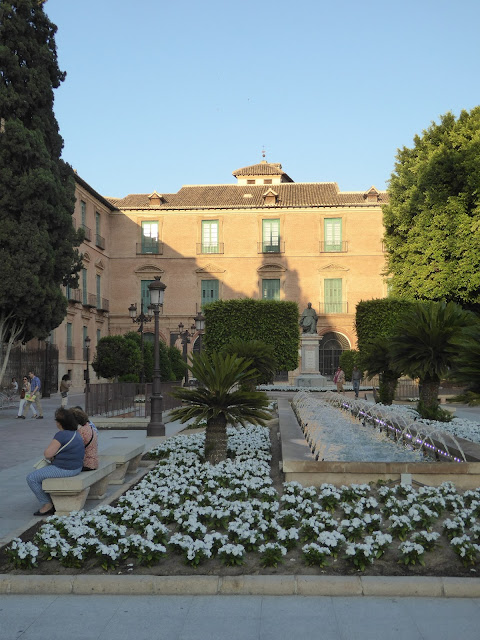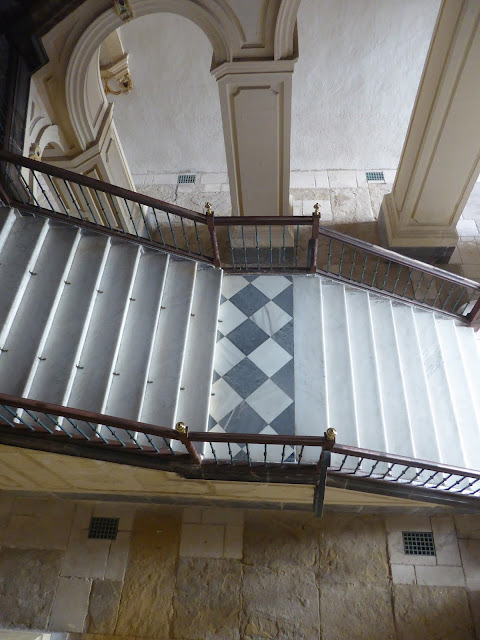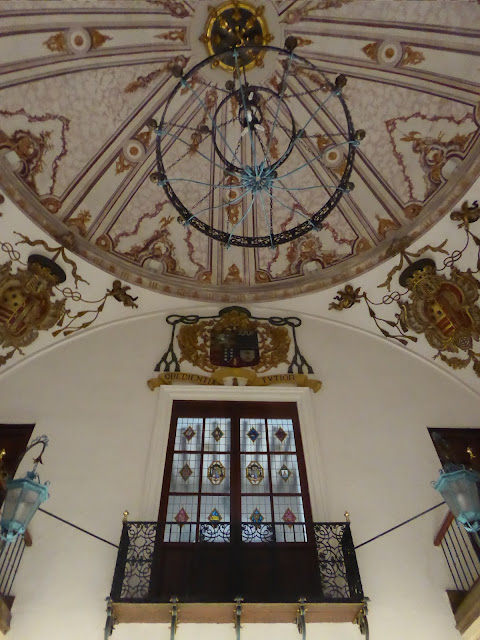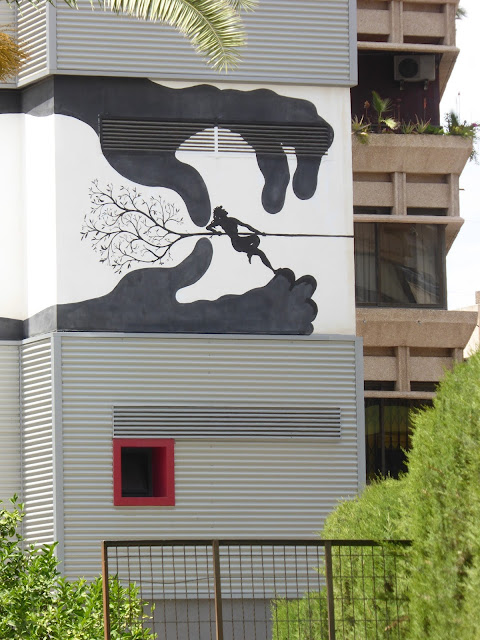MURCIA
Visiting Murcia was almost an afterthought. About an hour away from Cartagena, the train back to Valencia stopped there and since I knew of at least one building I wanted to see in the city, I alighted. Murcia is the capital of the region of Murcia that includes Cartagena. Inland from the sea, the city is a bustling urban and university center of about 450,000 people.
The Rio Segura splits the city in half, north to south, although most of the old town is located to the north of the still flowing river. Without the Mediterranean breezes, the city heats up considerably in the summer. When I was there it was already getting hot: in the upper 80s, low 90s and just a bit parched looking.
I found the city to be a surprise. Although the web guides describe a place that essentially only has a big cathedral and a Bishop's Palace, along with that one piece of significant contemporary architecture, the on-the-ground reality was much more dynamic. The building fabric in the old town is not frozen in time, but is a collection of the new, the old, the really old, and the ancient all of which reflects the nearly 1200-year history of the city.
There is bustling (non-tourist) commercial activity, hundreds of cafes and restaurants, and enough interesting sights throughout the city to occupy several days of exploration. The University of Murcia, which was first established in the thirteenth century, now services 38,000 students who clearly bring their own vibrancy to the city.
And yes, there is street art.
PLAZA CARDENAL BELLUGA
 |
This is Murcia's main square, Looking east is the Cathedral. To the right, south, is the Episcopal Palace of Murcia. To the left, north, is a commercial frontage composed mainly of cafes.
|
 |
To the west, opposite the Cathedral and across the long plaza, is supposedly the most important reason for an architect to visit Murcia: Rafeal Moneo's heavily publicized and discussed new annex to the main City Hall that is located a street away. Designed and built between 1991-1998, the structure is a case study on how to integrate contemporary architecture into the existing historic fabric of a city. Or not.
From one review: "The façade is the most important element of this building. Rafael Moneo focused all his efforts to compose it and that this one could compose in a dialogue with its environment. Moneo thought about a musical score for the order of the columns, and about a glass balcony to break the symmetry, and from which the mayor could appear to the city."
Well, maybe. At the same time, you could just say he played around until he found a composition of solids and voids he liked. It almost works. Unfortunately, the un-modulated(sic) almost blank wall that creates a 30 ft. high barrier at the base of the building almost destroys whatever Moneo has achieved above. Apparently, there was a great deal of civic resistance to having a entry to the building facing the square (a church vs. state argument), so Moneo left the facade blank at ground level to create a backdrop for formal events. Notice the long curved wall (yes, it is curved) at the base. See below for how this further isolates the building from the plaza.
This is one of those, "I suppose it could have been worse" achievements that make so many contemporary architects reviled among all but the cognoscenti. I took it in stride, made sure I visited the place both in daylight and at night, and moved on to the rest of the plaza and city. |
The curved wall facing the square hides a below-grade terrace off of the public cafeteria. (It was after-hours for the city hall, so all of the tables, chairs, and umbrellas had been removed for safe-keeping.) In one of the most pleasant plazas in the city, if you are unlucky enough to have to eat here, you get to stare at a blank stone wall. The wall itself was in constant use by the public to relax. But, as you can see, it is high enough that you need to be young enough to be able to hoist yourself up to sit on it. Simply adding another seating-height row of stone along the curve would have created a wonderful civic amenity.
|
Cathedral Church of Saint Mary in Murcia
1385-1467
 |
| The transepts are also devoid of seating, but have elaborate entry pavilions. |
The Episcopal Palace of Murcia
1748(42?)-1768(72?)

 |
| The rear, l-shaped facade of the Palace facing the river, on the Glorieta Espana, another of Murcia's fine pedestrian plazas., |
 |
| To the left and abutting the rear Palace facade is the original and still functioning 19th-century Casa Consistorial (Town Hall), Murcia's main City Hall. |
 |
| The entire Glorieta. (Photo by others.) |
LA CASA HABITADA
 |
| Facade of the Arts Faculty, University of Murcia viewed from the Plaza de la Universidad., part of the original, old city, La Merced campus. |
 |
| I believe that is a student housing residence for the University of Murcia. |
 |
| Various campus buildings, including the Museo de Belles Artes de Murcia. |
 |
| An in-tact, historic church facade, that has had some unfortunate additions (see below). |
 |
| 12th Century "Veronicas Wall," part of the defensive line of the Hispano-Muslim city. |
THE RIO SEGURA RIVERFRONT

*****


CALLE DE LA TRAPERIA
 |
| One of the city's major pedestrian streets. The green carpet is perhaps a bit egregious. |
 |
| El Real Casino de Murcia (Royal Casino of Murcia), a private social club dating back to its completion in 1847. |
 |
| Across the street, an art gallery. |
*****

MUSEO DE SANTA CLARA LA REAL
 |
| The Museum is part of an active convent complex that dates to the 14th century. It was built on the site of a 13th century Muslim alcazar.. |
 |
| Restored portion of the ceiling of the attached Baroque church. |
COLEGIO OFICIAL DE APAREJADORES, ARQUITECTOS TECNICOS E INGENIEROS DE EDIFICATION DE LA REGION DE MURCIA (COAATIEMU)
(The Association of Surveyors, Technical Architects and Building Engineers
of the Region of Murcia)
COLEGIO OFICIAL DE ARQUITECTOS DE LA REGION DE MURCIA (COAMU)
(The Association of Architects of the Region of Murcia)
____________________________________
Copyright © 2016-2021 Benjamin Clavan




















































































No comments:
Post a Comment